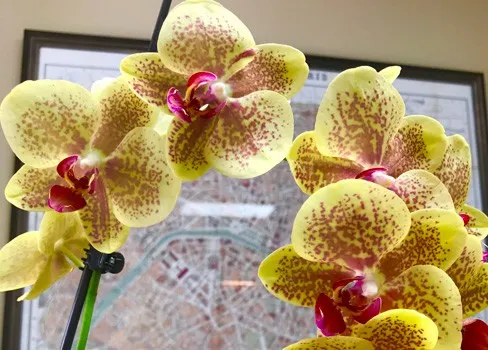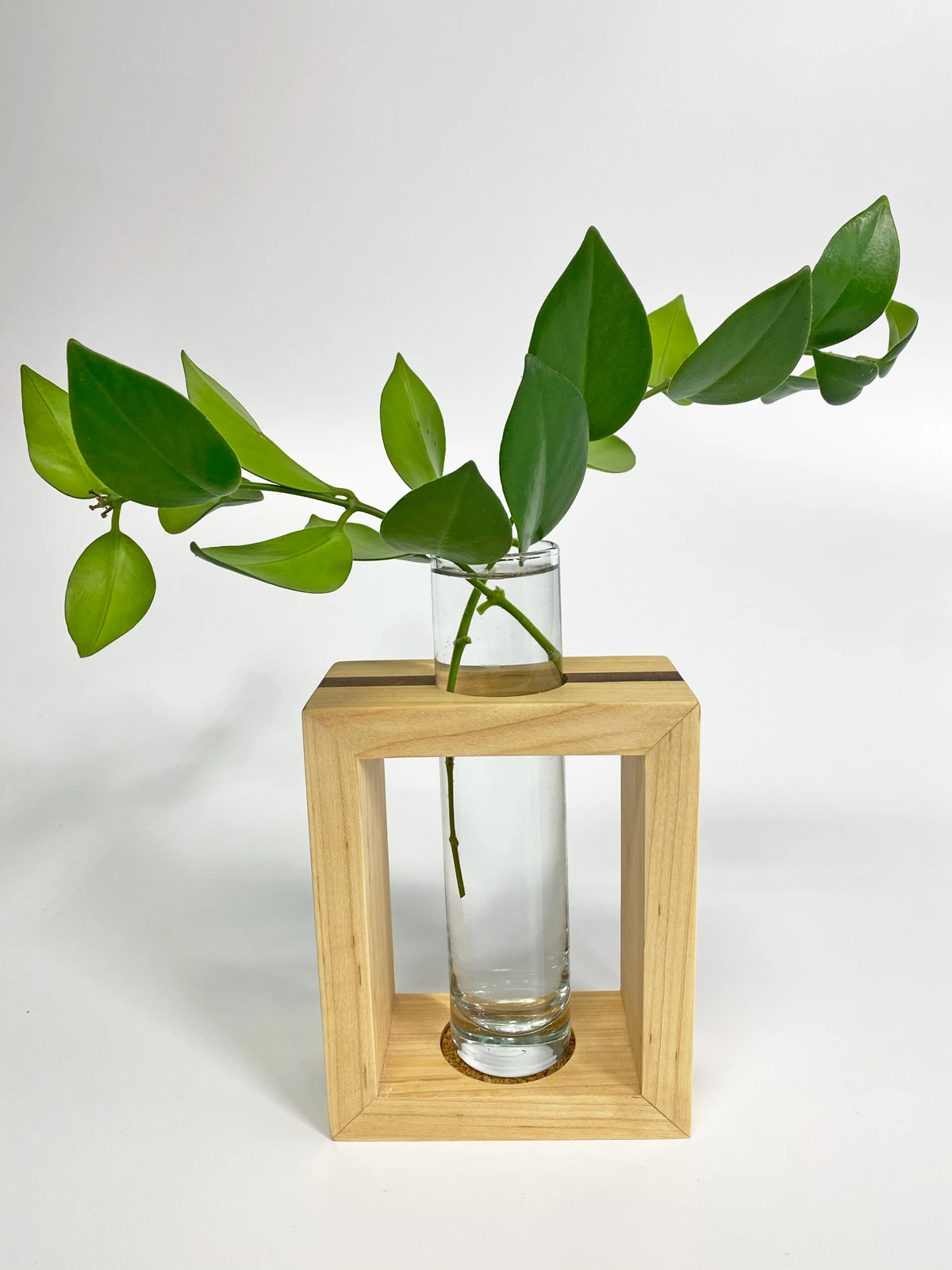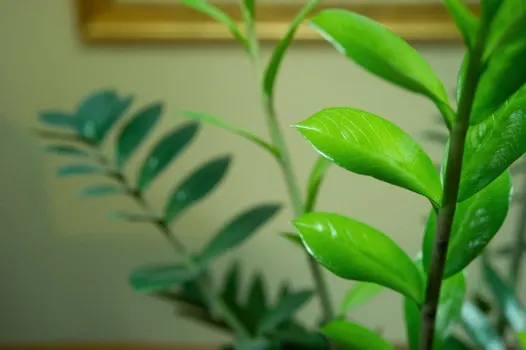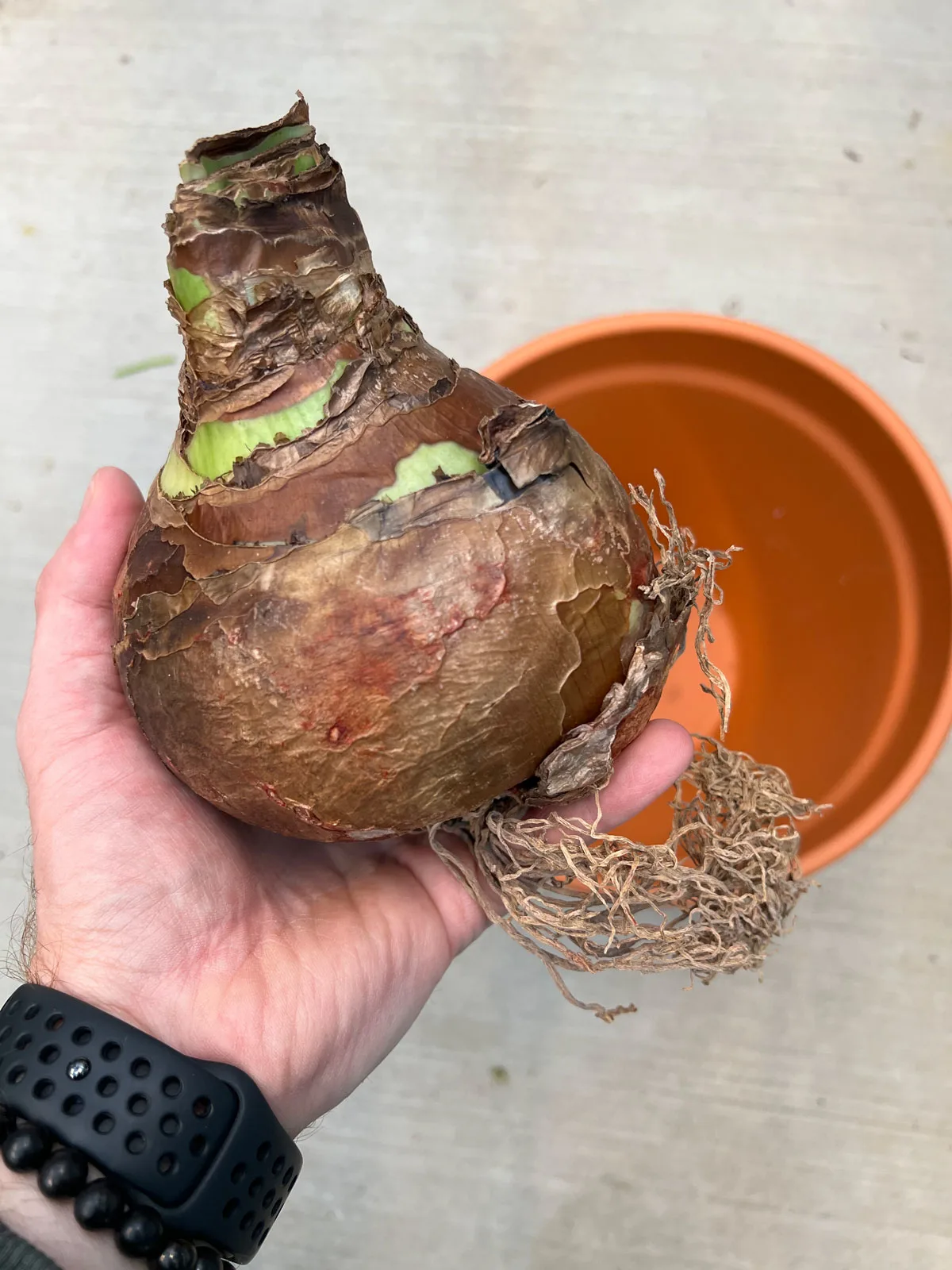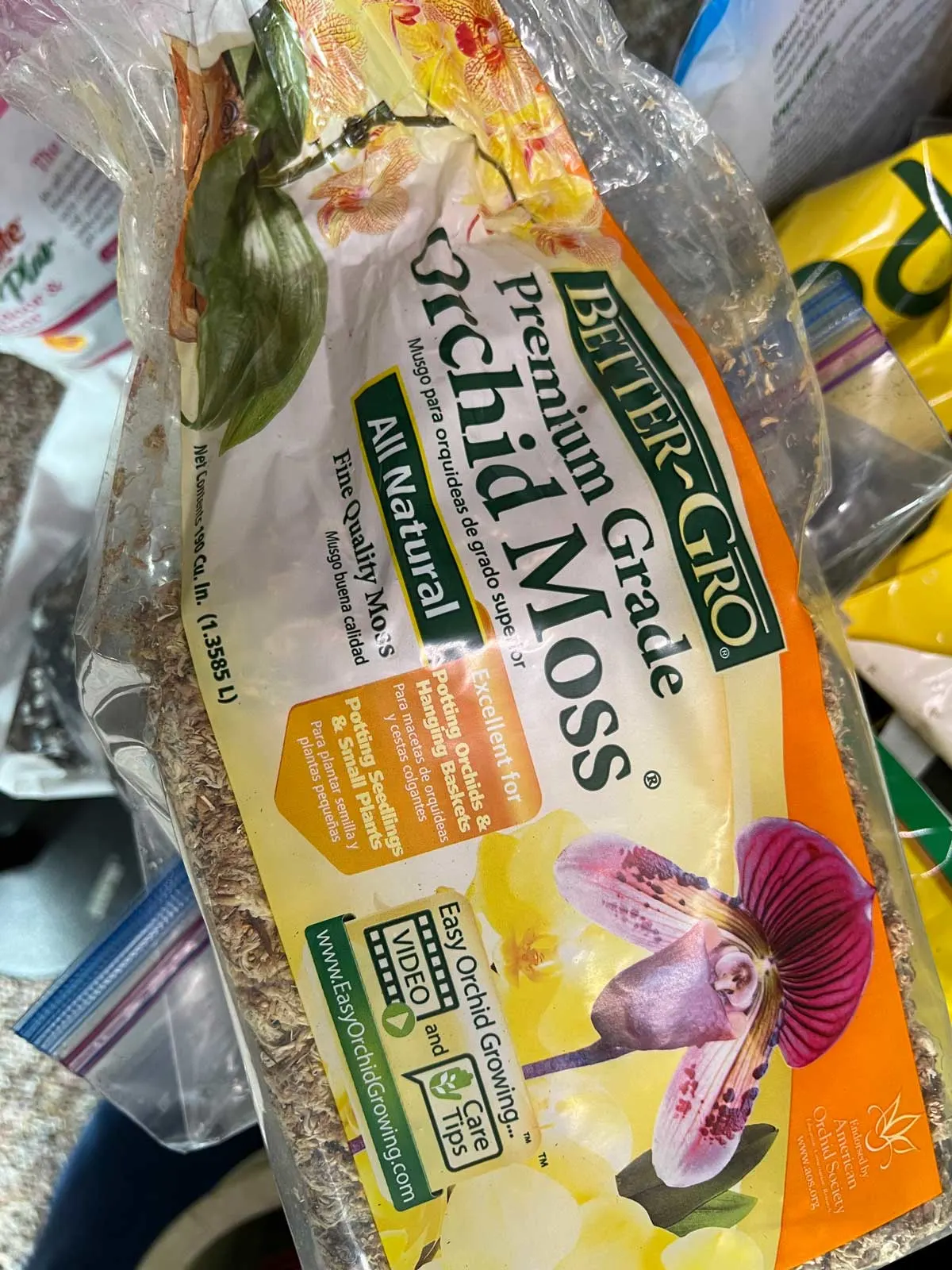Some of the links in this post may be affiliate links.
If you have been curious about growing houseplants in LECA, you’ve come to the right place. In this post, I interviewed a fellow houseplant enthusiast and friend of mine, who is a heavy user of LECA, to share her experiences!
“Semi-hydo” methods are becoming increasingly popular, so if you’ve wanted to experiment with growing houseplants in LECA, keep reading and I will show you step-by-step (with photos) how you can do the same!
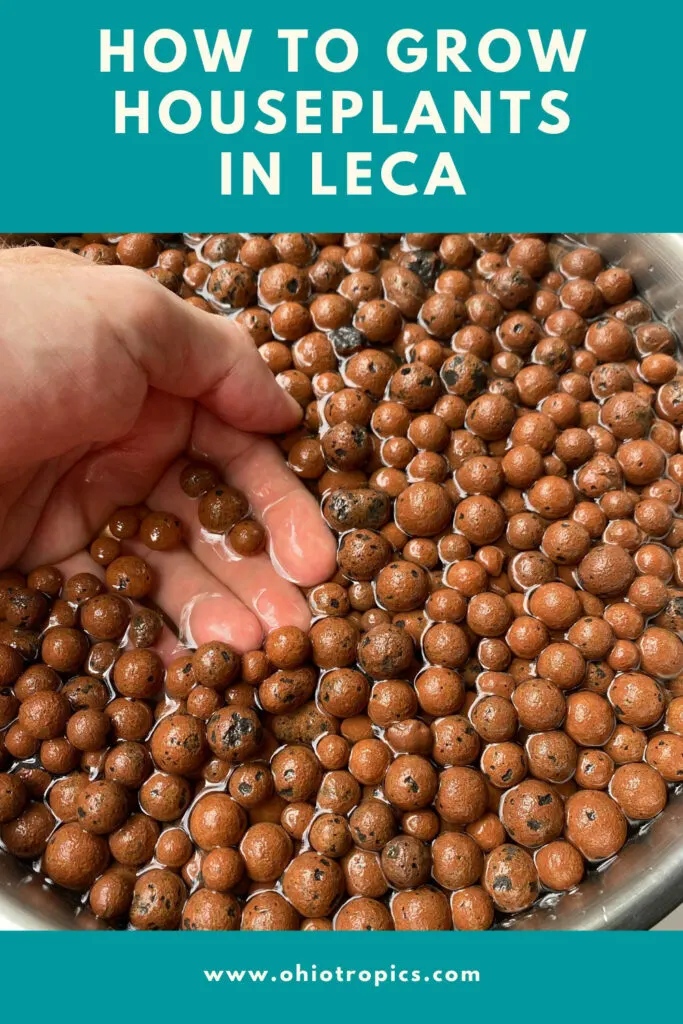
I will also go over what LECA is, the pros and cons of using it, how to prepare it for use, and exactly how to use it.
Table of Contents
But first…What is LECA?
LECA stands for lightweight expanded clay aggregate. It is made by simply by mining clay, forming it into pellets, and then using a kiln to heat to high temperatures (approximately 1200C or 2190F). They essentially pop like popcorn.
During the heating process, gases will expand the clay and form a lot of tiny bubbles. This results in a lightweight product that is ideal for many applications, including growing plants!
Clay naturally has good capillary action, so it lends itself very well to growing plants in. Capillary action is basically a phenomenon where liquids, like water, will flow into small spaces and often against the force of gravity.
This is why LECA works so well in self-watering set-ups where, through the assistance of a wick, will help facilitate the capillary action.
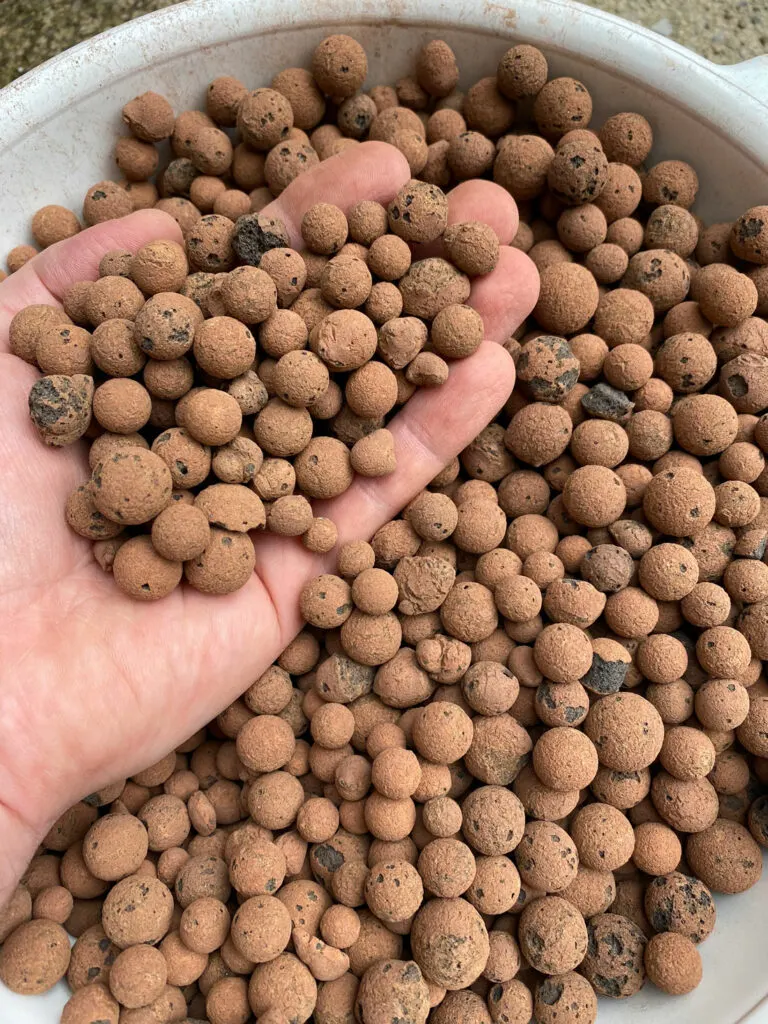
Pros and Cons of LECA
PROS
- It does not compact or decay over time.
- It is lightweight.
- If you’re mixing it in to amend potting mix, it will help to prevent soil compaction, as well as help increase oxygen in the root zone (due to the size of the balls as well as the porous nature of LECA).
- LECA is much less messy than using potting mixes.
- If you’re just using LECA and water as the main growing medium, there are numerous advantages:
- Fungus gnats become virtually non-existent. Fungus gnats grow and thrive in traditional potting mixes where organic materials are used. LECA is inorganic, making it inhospitable for them to grow.
- Because of the porous nature of LECA, if used properly, there is no risk of “overwatering.”
- It is much easier to determine when to water since you are simply trying to maintain the water level in your growing vessel.
CONS
- Set up costs and effort can be greater to get started. LECA is not as cost-effective as potting mix. In addition, you can use self-watering pots (which are much more expensive than traditional pots), or you can make your own set ups which will involve more effort.
- You’ll need to use a fertilizer solution when growing plants in just LECA. Unlike potting mixes, there are no nutrients in LECA.
- LECA doesn’t retain moisture as well as some other substrates, so you’ll need to make sure that your set up is done the right way and that your LECA balls never dry out.
- Measuring pH may be necessary. Most plants prefer a slightly acidic pH while growing (6.0-7.0 is a safe bet). Depending on the water you use, you may want to test the pH to be safe (or at least do so if you’re seeing any issues with your plant’s growth). pH is important since plants can only absorb certain nutrients in a give range of pH.
Preparing to Use LECA
Before you use LECA, it is important to prepare it properly, namely, rinsing and then soaking it before using.
First, go ahead and rinse your LECA balls out in order to wash away any dust. I like to set mine in a sieve or colander and do it outside so I’m not collecting any clay dust in my plumbing.
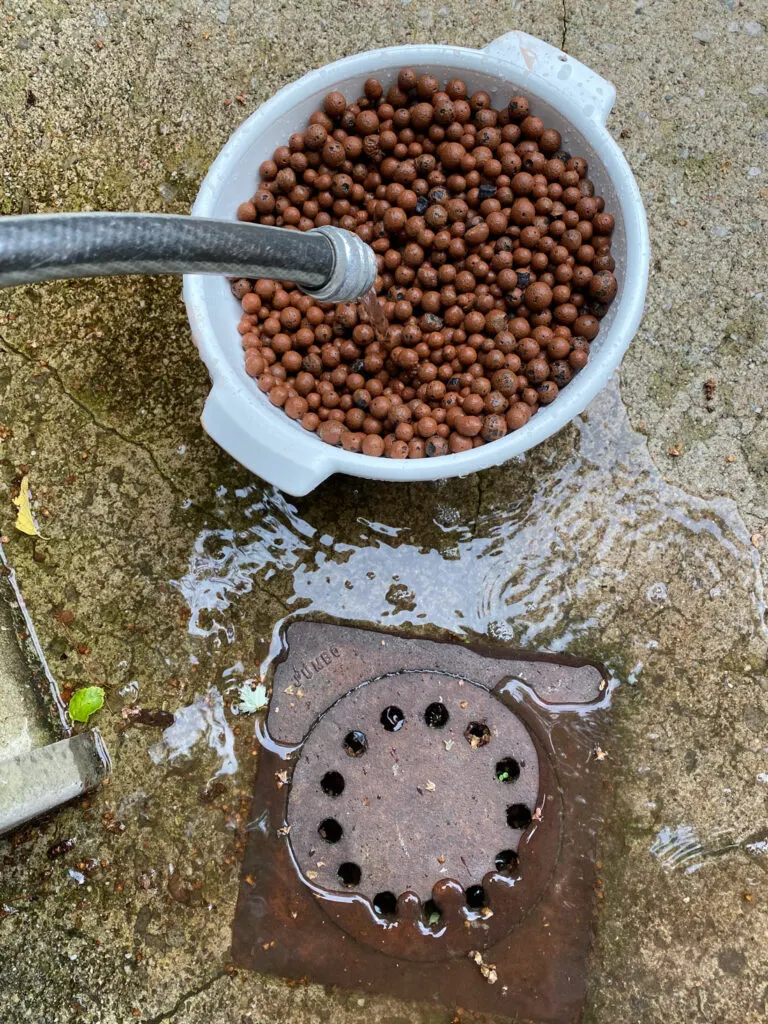
After you rinse it, place your LECA balls in a container of water, fill it up so that they are completely submerged and let them soak for 24-48 hours, and you may want to change the water at least once.
This will help to remove any remaining impurities from processing when LECA was made.
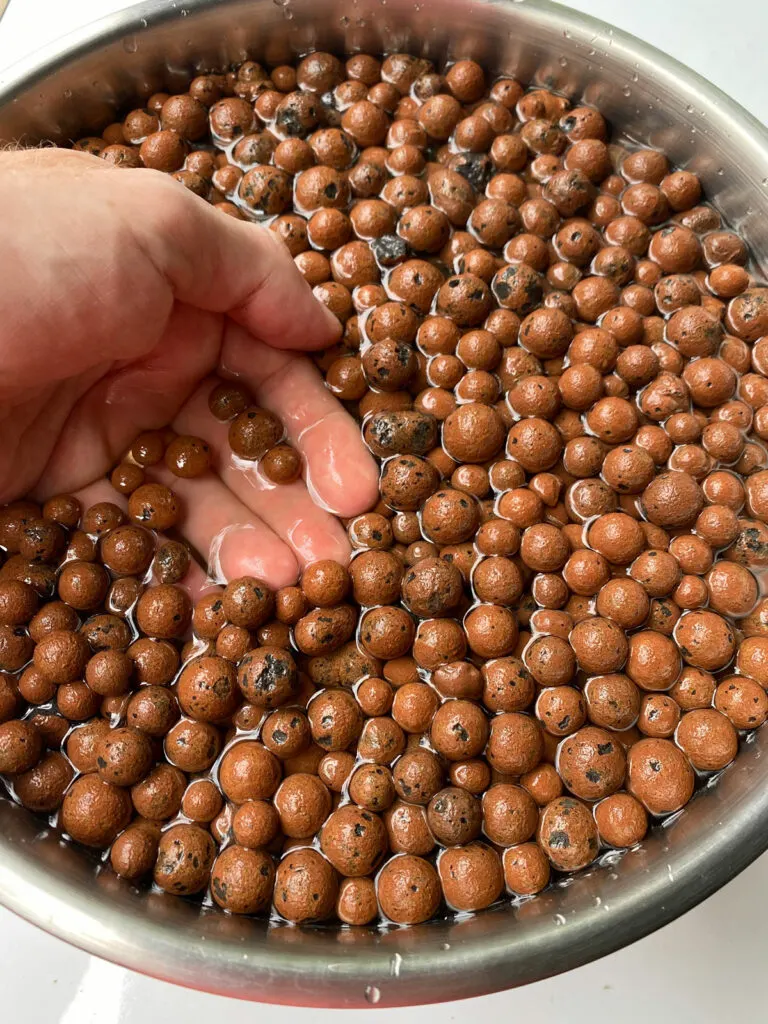
HOW TO GROW HOUSEPLANTS IN LECA
Now that the LECA has been prepared, it’s time to dive in and use it!
The photos in this section below are the property of my fellow plant cohort and friend melelina_cattleya on Instagram and I credited her photos in each caption. In the following section, I’m sharing her experiences and wisdom of using LECA, along with some of my own commentary.
CONVERTING FROM SOIL TO SEMI-HYDRO USING LECA
The following series of photos shows how to convert plants from soil-based growing to semi-hydro growing with LECA.
First, holes were drilled into the bottom of a plastic soup container. (You can use many different types of containers or even a nursery pot. Be creative!)
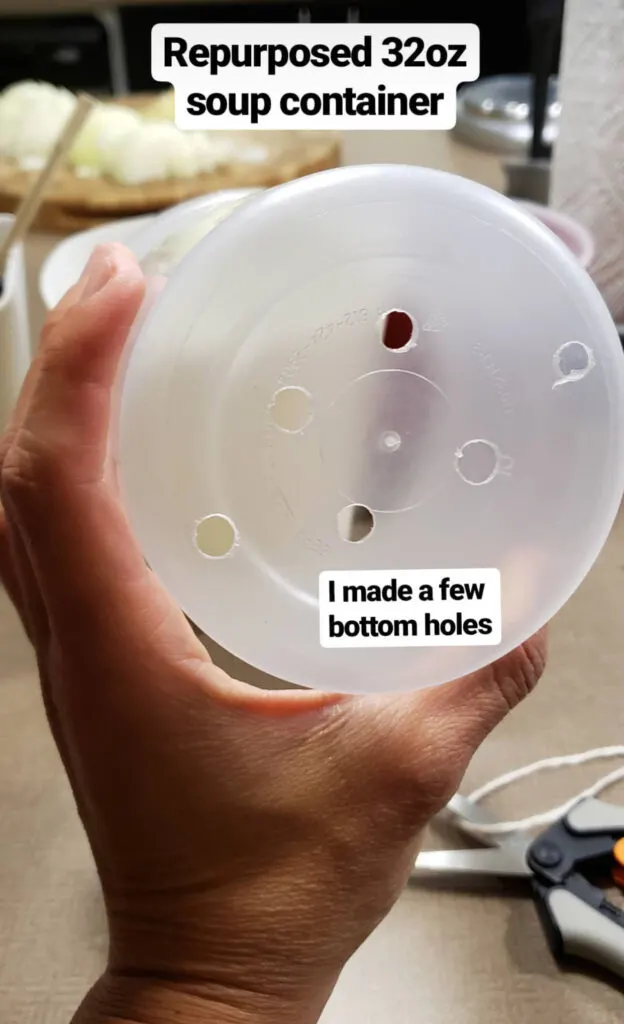
Next, a hole was drilled near the rim of the pot, shown below.
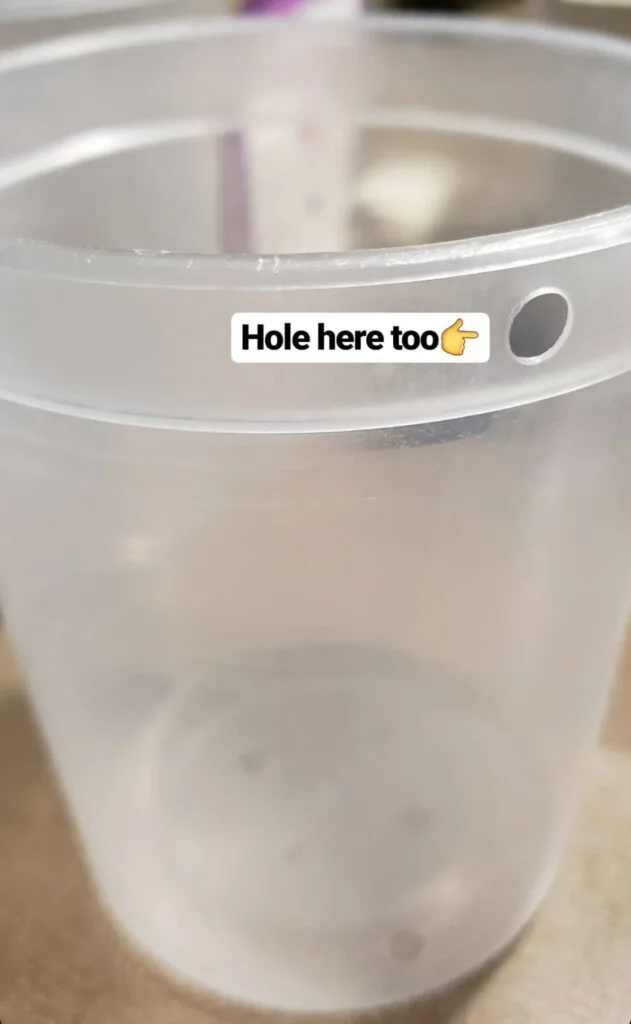
The hole allows you to install a handle (that you can easily make from twine, shown below) so you can easily lift the pot out of the outer pot that it will be placed in. The handle is not absolutely necessary, but it can make it a little easier to lift this inner pot out later on.
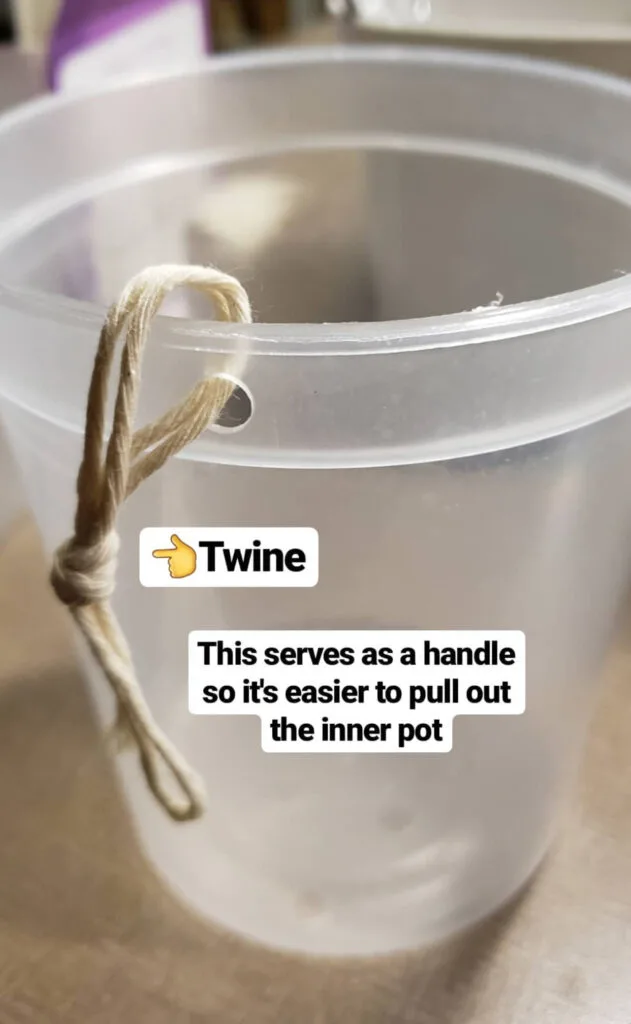
Next, obtain an outer pot that has no drainage holes. Ideally, you’ll want the outer pot to be a little taller and with an appropriate diameter so that the bottom of the inner pot does not touch the bottom of the outer pot.
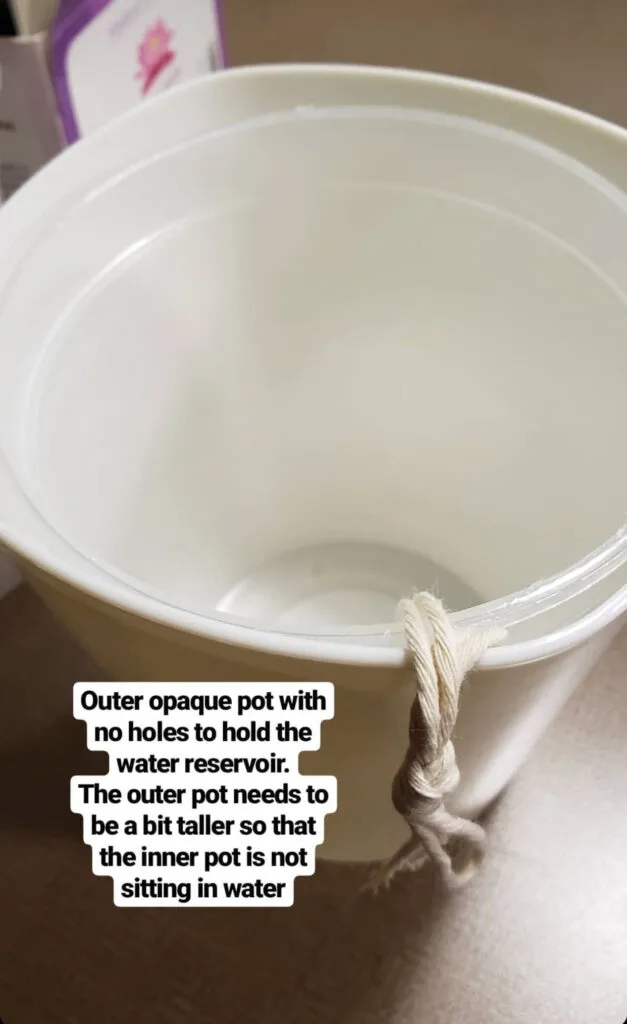
Next, in the photo below, a lemon lime Peperomia was removed from its pot and as much soil as possible was rinsed off.
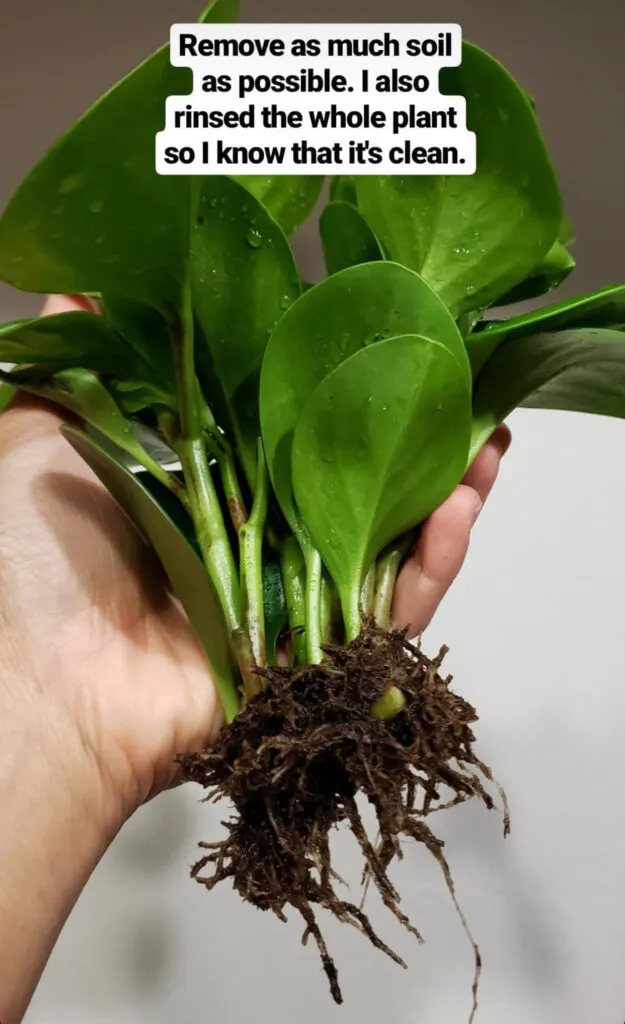
Next, thread a synthetic blanket yarn through so that the two cut ends extend out a couple inches from the bottom of the drainage holes just like in the photo below.
The yarn will serve to wick water from the bottom of the outer pot up into the LECA, through capillary action.
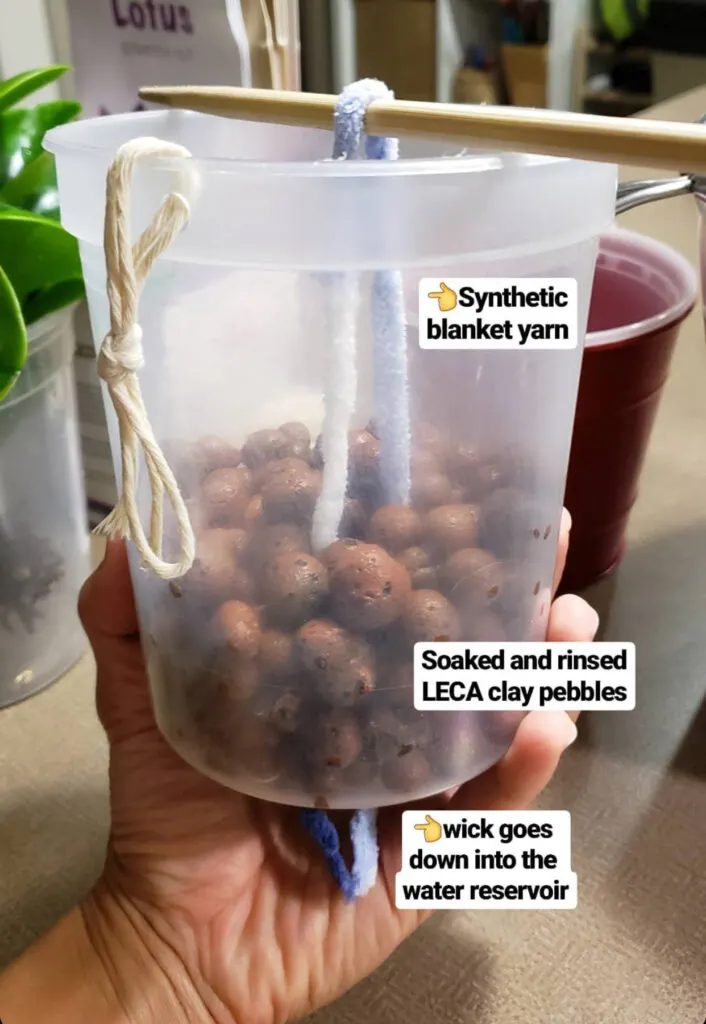
Melelina_cattleya likes to use Bernat Baby Blanket 100% Polyester yarn that you can easily buy on Amazon.
I myself like to use Orimerc Self Watering Capillary Wick Cord. Both of these are good options. You want to avoid anything that is cotton since it will eventually rot.
Next, place your plant (which you’ve rinsed the soil off the roots) inside your inner pot that you’ve filled with rinsed and soaked LECA.
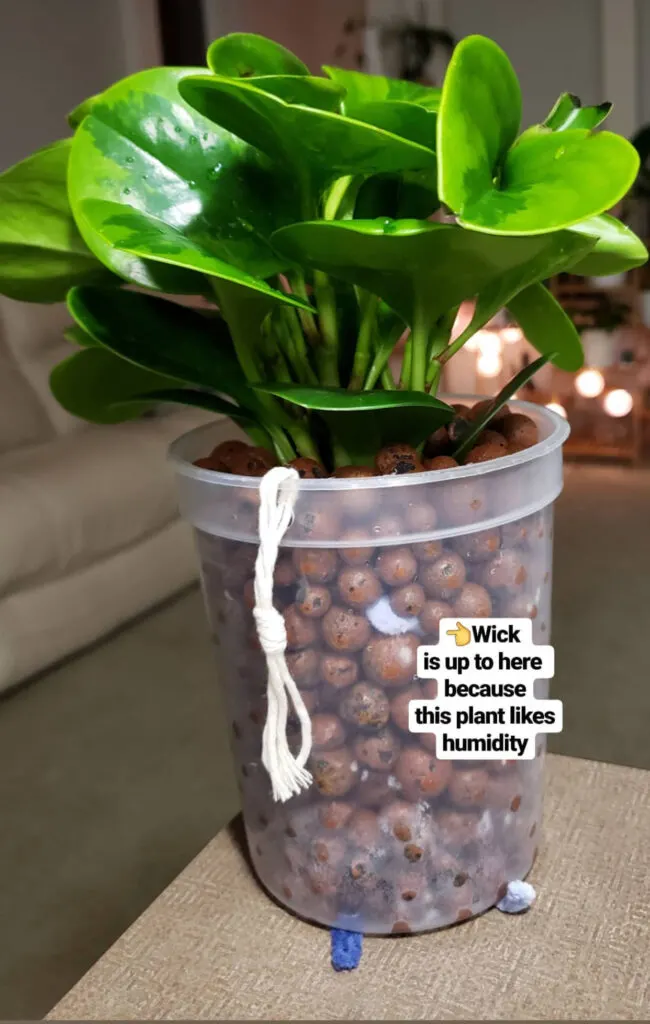
Lastly, place the inner pot inside of the outer decorative pot, and add a little water to your new set-up. Ideally, you’ll want to add enough water so that the water level is right under the level of the inner pot.
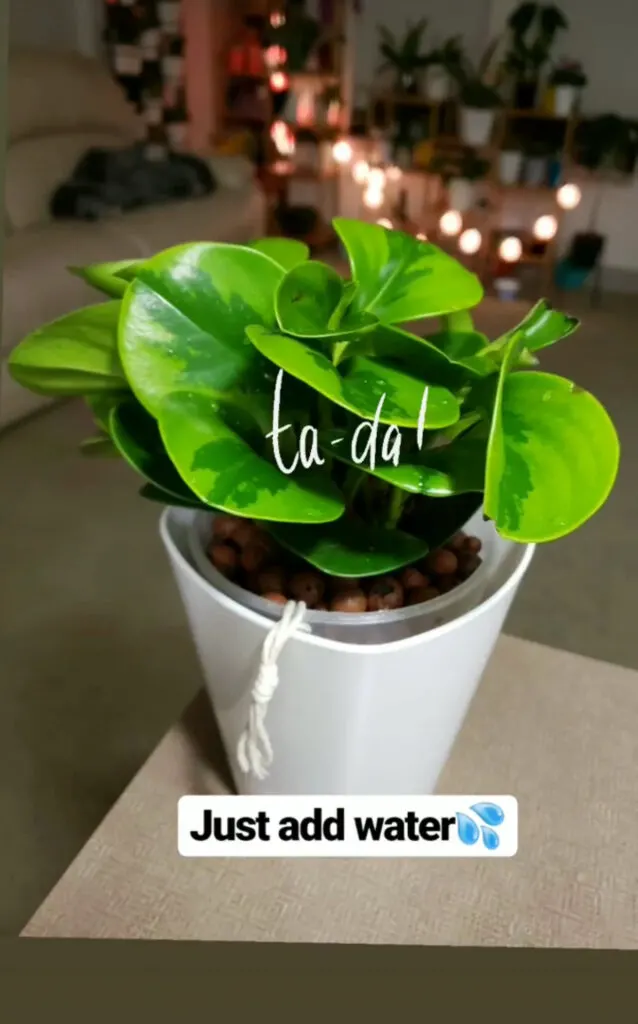
To clarify a bit, take a look at a different set up below. With the Phalaenopsis orchid below, the inner pot with the orchid and LECA balls are set inside of a glass jar. Here you can clearly see that the water level is below the bottom of the inner pot, but with wick still in the water.
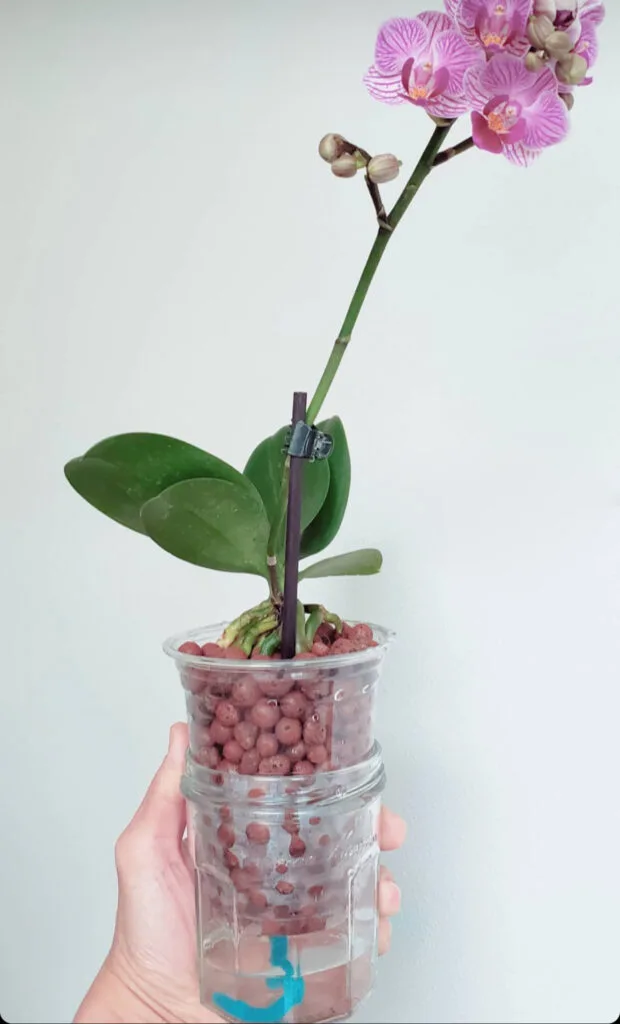
At this point, all you have to do is monitor the water level and you’re set! Be careful to never let the water reservoir completely run out. Once it’s time to water, just simply water from the top and let the water stream through the LECA and collect in the outer pot.
If your wick and LECA go dry, you’ll have to take your inner pot out, and flush it well with water to moisten everything before setting your system back up.
If you’d like to purchase a self-watering pot instead of making a DIY set-up, check out my Growing Orchids in LECA and Water blog post where I show everything I did step-by-step with photos.
MORE LECA TIPS
Lastly, I asked melelina_cattleya some additional questions about her experiences with LECA. Here is some more useful wisdom:
Why did you start growing in LECA? What do you like most about it?
“My plant obsession started with orchids. I tried growing them in bark and moss but it just didn’t work for me. I kept killing them. LECA worked for me and that’s when it all started. I love how LECA doesn’t decompose and it’s easier and cleaner to deal with compared to soil/bark or other organic media.”
Do you grow everything in LECA? Is there anything that you won’t grow in LECA?
“Most, not all. My succulents and cacti are in cactus soil although I do have a succulent growing in LECA as an experiment. It’s doing well. My outdoor plants are all in soil. I just started growing carnivorous plants and those I will not grow in LECA.”
How do you use LECA? Do you propagate and grow your plants from there, or do you convert existing plants from soil to LECA?
“I actually do both. Fresh cuttings, like hoyas, root really well in LECA. I’ve also converted a bunch of plants and orchids from soil/bark to LECA.”
Is there any maintenance involved with the actual LECA? Does it ever need to be cleaned?
“I soak it and rinse it before first use (to get rid of dust). If I need to reuse LECA for a different plant, I boil it to disinfect it just in case the previous plant had any disease. It’s also good practice to flush LECA once in a while to get rid of accumulated salts. Some people test pH but I don’t because I’m lazy and so far haven’t had problems.”
What is your fertilizing routine with using LECA? What fertilizers do you use?
Melelina_cattleya uses Feed Me! for orchids and houseplants, and Hawaiian Bud & Bloom for her Adeniums.
Personally, instead of the two products above, I’ve been using Dyna-Gro Grow and Dyna-Gro Bloom. I use “Grow” for leafy houseplants and “Bloom” for anything that flowers.
There are tons of fertilizers, so don’t be afraid to experiment and see what works best for you.
Do you have a particular brand of LECA that you like using?
“I use 3 different ones, actually. I get LECA from IKEA, Home Depot and also Amazon.”
Mother Earth Hydroton Original Expanded Clay Pebbles from Amazon is a high-quality brand of LECA.
Do you use LECA by itself, or do you ever mix it with soil?
“Usually by itself. I’ve been experimenting with a DIY Pon medium and I mix LECA with that. Also when I make terrariums I sometimes use LECA as the bottom drainage layer.”
Do you find that plants growing in your LECA setups perform better than plants growing in potting mix?
“I don’t have multiple plants growing in soil and LECA to compare. Right now I have 3 Philodendron ‘Birkin’ growing in LECA, pon and cactus soil and they’re all doing great. I also have a Pilea in cactus soil and one in LECA and both are doing well.”
“To be honest, I’m more comfortable using LECA than soil for houseplants because I can never tell when it’s time to water (I don’t like sticking my finger in the soil.) For the plants in LECA, when the reservoir is low, I water. Easy!”
FREQUENTLY ASKED LECA QUESTIONS
What plants can you grow in LECA?
You can essentially grow any plant in LECA, but if you are transferring a plant from soil to LECA, you will have a much higher success rate if you use a smaller plant to start. Avoid older or big plants. Regardless, if you are converting from soil to LECA, expect a transition period of a few weeks and don’t be alarmed if you see a yellow leaf or two or the plant isn’t growing. It will need a bit of time to adjust.
Can I mix LECA with soil?
Absolutely. LECA has the advantage of not decomposing, so you can mix some in with your potting mix blends. It will help improve drainage, prevent compaction, as well as allow more oxygen to remain in the root zone, therefore helping to decrease the risk of root rot.
How often do you water plants in LECA?
This can vary depending on your growing conditions, so you’ll have to closely monitor the water level and make sure you keep it at an appropriate level and don’t let it dry out completely.
Should I soak LECA before using it?
Yes, you’ll want to soak your LECA for two reasons. First to rinse off any dust. Second, you’ll want to soak it 24-48 hours before use to remove any impurities and to condition it properly for effective use for your plants.
Can I use dry LECA?
It is not advisable to use dry LECA. Because of capillary action, LECA essentially wicks away moisture and thus dry out roots too quickly. Always use LECA that has been soaked and is still wet.
Have you used LECA before? How do you like to use it? Many different set-ups are possible, so comment below if you’d like to share how you like to use it!


